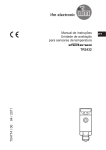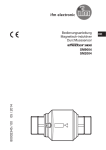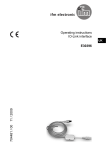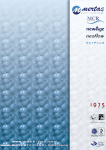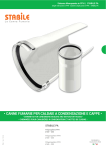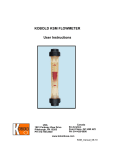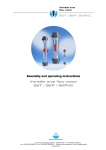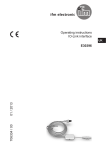Download Operating instructions Memory plug E30398
Transcript
Operating instructions Memory plug UK 704930/02 11/2011 E30398 Contents 1 Preliminary note���������������������������������������������������������������������������������������������������3 1.1 Symbols used������������������������������������������������������������������������������������������������3 1.2 Terms used����������������������������������������������������������������������������������������������������3 2 Safety instructions�����������������������������������������������������������������������������������������������4 3 Factory setting�����������������������������������������������������������������������������������������������������4 4 Functions and features����������������������������������������������������������������������������������������5 4.1 Applications without PC���������������������������������������������������������������������������������5 4.2 Applications with PC��������������������������������������������������������������������������������������5 4.3 Basic operating conditions�����������������������������������������������������������������������������5 5 Electrical connection��������������������������������������������������������������������������������������������6 6 Operation�������������������������������������������������������������������������������������������������������������7 6.1 Save the parameter set of a sensor once �����������������������������������������������������7 6.2 Save the parameter set of a sensor continuously ����������������������������������������8 6.3 Copy the parameter set of a sensor �������������������������������������������������������������9 6.4 Set the parameters of the replacement sensor�������������������������������������������10 6.5 Restore the parameter set of a sensor�������������������������������������������������������� 11 6.6 Write to the memory plug via PC�����������������������������������������������������������������12 6.7 Read from the memory plug via PC������������������������������������������������������������14 6.8 Use the memory plug as data carrier����������������������������������������������������������16 6.9 Operating indicators������������������������������������������������������������������������������������17 7 Configure the memory plug�������������������������������������������������������������������������������18 7.1 Configuration via PC������������������������������������������������������������������������������������18 7.2 Configuration via teach button���������������������������������������������������������������������20 8 Scale drawing����������������������������������������������������������������������������������������������������22 9 Technical data����������������������������������������������������������������������������������������������������23 10 Troubleshooting�����������������������������������������������������������������������������������������������25 2 1 Preliminary note 1.1 Symbols used ► > → Instructions Reaction, result Cross-reference Important note Non-compliance can result in malfunction or interference. Information Supplementary note. UK LED on LED off LED flashes slowly (1 Hz) LED flashes quickly (4 Hz) LED flickers 1.2 Terms used Memory plug Plug with storage medium Memory plug empty Setting at the factory. No parameter set is saved in the memory plug. The memory plug has to be connected to a sensor or a PC system in order to save a valid parameter set. Memory plug full A valid parameter set is available in the memory of the memory plug. Memory plug trans- The memory plug is transparent if after successful saving parent of the parameters all unfiltered sensor signals are transmitted to the higher-level system. For further data operation the operating voltage or the connection sensor - memory plug must be interrupted once. 3 [Write protected] [Read/Write] Sensor of the same type Identical sensor IODD • If the memory plug is empty (no parameter set saved), a parameter set can be saved. • If the memory plug is full (a parameter set is saved), it is protected against further writing. A parameter set can be written to the memory plug. It is not protected against overwriting. Sensors of the same type have the same IO-Link device ID. The series number may be different. The IO-Link device ID is an unambiguous device identification assigned by the manufacturer. Physically identical device: The series number of the sensor and the saved parameter set are the same. = abbreviation for IO Device Description. It is a file describing the parameters of the IO-link devices. This file can be interpreted by machines. An IODD is assigned to each IO-Link device ID. 2 Safety instructions • Please read this document prior to set-up of the unit. Ensure that the product is suitable for your application without any restrictions. • If the operating instructions or the technical data are not adhered to, personal injury and/or damage to property can occur. • If you change parameters during operation, this will influence the function. Ensure that no malfunction or dangerous conditions will occur in the plant. 3 Factory setting On delivery the memory plug is empty (no parameter set saved). When the supply voltage is applied, the LED WRITE flashes slowly (1 Hz). 4 In this state one parameter set can be written to the memory plug once. Then it changes to the mode [Write protected]. 4 Functions and features The memory plug saves parameter sets of IO-Link devices. It offers the following UK options: • Bi-directional backup for IO-Link V1.1 sensors. • Bi-directional backup for IO-Link V1.0 sensors from ifm electronic. • Preconfiguration as data carrier via PC. 4.1 Applications without PC • Save the parameter set of a sensor once → 6.1. • Save the parameter set of a sensor continuously → 6.2. • Copy the parameter set of a sensor (copy to several sensors of the same type; e.g. in series production or for fast set-up) → 6.3. • Set the parameters of replacement sensors (without using further tools, without configuration tools or menu handling) → 6.4. • Restore the parameter set of a sensor (e.g. during start-up of an installation) → 5.5. 4.2 Applications with PC • Write to the memory plug via PC (save the parameter set in the memory plug) → 6.6. • Read the memory plug via PC → 6.7. • Use the memory plug as data carrier → 6.8. • Configure the memory plug via PC → 7.1. 4.3 Basic operating conditions • Negative switching sensors are not supported. • The memory plug cannot be used with IO-Link actuators. • The memory plug is intended for saving the data of IO-Link sensors used without IO-Link master. 5 • Data in the parameter set of the sensor protected by an access code cannot be overwritten by the memory plug. The memory plug saves / writes data after the following operations: • After application of the supply voltage. • After interrupting and restoring the connection between the memory plug and the sensor. After saving the parameters all sensor signals are linked through without being changed. The output function of the sensor, its quality and speed remain unchanged. An integrated memory plug does not influence the complete system. Recommended operating mode: Operation in the [Write protected] mode is recommended. This mode ensures that a parameter set is not unintentionally overwritten. In the [Read/ Write] mode the memory plug is not write-protected! The manufacturer of an IO-Link sensor is responsible for providing all parameters necessary for an exchange. The memory plug reads this information from the sensor and saves exactly these parameters. The memory plug cannot be used in a system with IO-Link master. The functionality of the system cannot be guaranteed. 5 Electrical connection The memory plug is an accessory intended for connection to IO-Link devices. 1 1 1: Sensor 2: Memory plug 6 2 1 BN 2 2 WH 4 4 BK 3 3 BU L+ Out 2 Out 1 L 6 Operation 6.1 Save the parameter set of a sensor once Requirement: The memory plug is used as delivered (empty / [Write protected]). 1 ►► Connect the memory plug to the supply voltage. Ub 2 ►► Connect memory plug and sensor. >> The memory plug reads the parameter set of the sensor and saves it. P Ub UK Reading process P Process terminated. Memory plug full / [Write protected]. The empty memory plug can carry out this process only once. It can however be reset to the factory setting (→ 7 Configure the memory plug). Do not install a brand new memory plug before setting the sensor parameters. If it is integrated before the parameter setting has been completed, it saves a non-optimised parameter set and any further change in the parameter set of the connected sensor is undone. 7 6.2 Save the parameter set of a sensor continuously Requirement: memory plug in the [Read/Write] mode To change from [Write protected] to [Read/Write] → 7 Configure memory plug. 1 ►► Connect the memory plug between the sensor and the evaluation unit of the installation. Display when the memory plug is empty Ub P Display when the memory plug is full 2 The parameter set of the sensor is changed (P → P1). Ub 3 P1 ►► Disconnect the memory plug from the sensor and connect it again. >> The memory plug reads the changed parameter set P1 and saves it. P1 Ub 8 P1 Reading process Process terminated 6.3 Copy the parameter set of a sensor Requirement: memory plug full / in the mode [Write protected] 1 ►► Connect the memory plug to the supply voltage. Ub 2 ►► Connect the memory plug with a sensor of the same type. >> The memory plug writes its parameter set to the sensor. P UK Writing process Ub Process terminated 3 ►► Repeat the process with sensors of the same type as often as you wish. Ub P This process only works for sensors of the same type (= sensors with the same IO-Link device ID). 9 6.4 Set the parameters of the replacement sensor Requirement: memory plug full / in the mode [Write protected] or [Read/Write] [Write protected] [Read/Write] Writing process Writing process Process terminated Process terminated 1 ►► Connect the memory plug to the supply voltage. Ub 2 ►► Connect the memory plug with a sensor of the same type. If the memory plug is used in the [Read/Write] mode, the sensor must have the factory setting. If in doubt reset the sensor. >> The memory plug writes its parameter set to the new sensor. P Ub 10 6.5 Restore the parameter set of a sensor Requirement: memory plug full / in the mode [Write protected] 1 ►► Connect the memory plug between the sensor and the evaluation unit of the installation. Ub P UK 2 The parameter set of the sensor is changed (P → P1). Ub P1 ►► Switch the supply voltage of the installation off and on again. >> The memory plug writes the original parameter set P to the sensor. I 0 P Writing process Process terminated 11 6.6 Write to the memory plug via PC You need the IO-Link interface (order no. E30396) to connect the memory plug to a PC. ►► Start the FDT service program ifm Container in the point-to-point mode. ►► Select offline mode. >> The list of the available IO-Link devices is displayed. ►► Mark the IO-Link sensor the parameter set of which is to be written in the memory plug in the list. ►► Continue with [Next]. 12 UK ►► Set the parameters as requested. ►► Connect the memory plug via the IO-Link interface. ►► Click on the symbol [Download]. >> The parameter set is saved in the memory plug. If the Memory Plug is connected to a sensor after this operation, it writes the saved parameter set in the sensor. Then the parameter set of the sensor is saved again in the Memory Plug for verification. 13 6.7 Read from the memory plug via PC ►► Connect the memory plug via the IO-Link interface. ►► Start the FDT service program ifm Container in the point-to-point mode. ►► Activate the option field [Automatic device selection (online)] and continue with [Next]. 14 >> The memory plug transmits its saved parameter set. UK >> The parameter set in the memory plug is displayed together with the photo of the sensor concerned (here TR2432). • 15 This allows the following possibilities: • Check the current parameter setting. • Change the current parameter setting. • Save the changed parameter set in the Memory Plug. ►► Click on the symbol [Download]. If the Memory Plug is connected to a sensor after this operation, it writes the saved parameter set in the sensor. Then the parameter set of the sensor is saved again in the Memory Plug for verification. • Save the changed parameter set in the FDT service program ifm Container. ►► Click on the symbol [Save]. 6.8 Use the memory plug as data carrier Memory plugs can be used as external storage medium: ►► When the installation has been set up, keep units with saved parameter sets in a safe place. 16 6.9 Operating indicators No supply voltage. Memory plug with factory setting (= no parameter set saved) After one writing process change to the [Write protected] mode. Memory plug with saved parameter set in the [Write protected] mode. UK Memory plug without saved parameter set in the [Read/Write] mode. Memory plug with saved parameter set in the [Read/Write] mode. Memory plug reads the parameter set of the sensor. Memory plug writes the saved parameter set in the sensor. Memory plug in the [Read/Write] mode; error in data processing. Memory plug in the [Write protected] mode; error in data processing. The connected sensor is not of the same type. This state remains until a sensor of the same type is connected or the voltage supply is interrupted. 17 7 Configure the memory plug 7.1 Configuration via PC ►► Start the FDT service program ifm Container in the point-to-point mode. ►► Select offline mode. >> The list of the available IO-Link devices is displayed. ►► Mark the memory plug in the list. ►► Continue with [Next]. 18 ►► Connect the memory plug via the IO-Link interface. ►► Click on the symbol [Connect]. >> The current setting of the memory plug is indicated in the status display (1). UK 1 2 3 4 1: status display 2: button [Reset] 3: button [Write Protect] 4: button [Read-Write]] ►► Press the requested button to change the setting: -- Reset] (2) restores the factory setting of the memory plug. -- The memory plug is set to the mode [Write protected] by [Write Protect] (3). -- The memory plug is set to the mode [Read/Write] by [Read-Write] (4). >> The command is immediately sent to the connected memory plug, the status display (1) is updated. 19 7.2 Configuration via teach button 3 1 1 1 1 1 BN 2 2 2 2 WH 4 4 4 BK 3 3 3 BU 2 4 3 L+ L T 1: sensor 2: memory plug 3: teach button (available as accessories; order no. E30405) T = button No sensor may be connected. ►► Press the teach button for the indicated time (the end of the time span is signalled by a change of the LED display; → following figures). Change from [Write protected] to [Read/Write] +Ub t [s] 0 A B A: LED display memory plug empty B: LED display memory plug full 20 10 <13 Change from [Read/Write] to [Write protected] +Ub t [s] 0 10 <13 A B UK A: LED display memory plug empty B: LED display memory plug full Restore the factory setting of the memory plug +Ub t [s] 0 10 15 <18 A A: LED display memory plug 21 8 Scale drawing 25 M12x1 18 22 52 LED M12x1 2 Dimensions in mm 1: connection for voltage supply and output signals 2: connection for sensor 22 9 Technical data IO-Link master The memory plug acts as master if it is connected with a sensor. Type of transmission COM1 (4.8 kBaud), COM2 (38.4 kBaud), (COM3 [230 kBaud] is not supported) IO-Link revision 1.1 SDCI standard IEC 61131-9 (Draft) Number of ports 1 Port class A Pin 2 electrically connected Smallest detectable current 3 for sensor detection [mA] UK IO-Link device The memory plug acts as device if it is used with the ifm Container FDT service program. Type of transmission COM2 (38.4 kbaud) IO-Link revision 1.1 Profile no profile SIO mode no Required master port class A (for parameter setting) Analogue process data none Binary process data none Min. process cycle time [ms] 2.5 Operating voltage [V] Current consumption [mA] Load current [A] Voltage drop [V] Short-circuit protection Reverse polarity protection Overload protection Storage capacity 18 … 32 DC < 35 0.5 / 2 (50 ms) 0.5 according to the connected sensor yes according to the connected sensor max. 2 Kbytes 23 Power-on delay time Ambient temperature [°C] Storage temperature [°C] Protection rating Protection class Insulation resistance [MΩ ] Shock resistance Vibration resistance EMC Housing materials Connection 24 according to the baud rate, data organisation, storage volume and communication behaviour of the connected sensor; typical values [s]: Storage volume Baud rate 0.1 K 0.5 K 1K 2K 4.8 kbaud 4.5 s 10 s 20 s 40 s 38.4 kbaud 0.5 s 1.3 s 2.5 s 5s Example: For a sensor with approx. 20 parameters, a storage volume of 0.1 K and a baud rate of 38.4 kBaud the memory plug needs a power-on delay time of max. 0.5 s + delay time of the connected sensor. If the parameters of sensor and memory plug are identical, this time is reduced considerably. -25...70 -40…85 IP 65, IP 67 III > 100 (500 V DC) DIN IEC 68-2-27 50 g (11 ms) DIN IEC 68-2-6 20 g (10...2000 Hz) EN 61000-6-2 PA PACM 12 (TROGAMID); PET; sealing: FPM (Viton); coupling nut: high-grade stainless steel (316L/1.4404); connector: TPU M12 connector 10 Troubleshooting For all errors the following applies: • The parameter set in the memory plug remains. It is not damaged by faulty reading or writing. • The error remains until it has been removed. • If the memory plug detects an error, the transmission of the sensor output (OUT1, pin 4) to the higher-level system is stopped. Error in data processing Cause of the fault Sensor cable removed during transmission. Unknown sensor connected, e.g. •IO-Link 1.0 sensor of another manufacturer. •Sensor not equipped with IO-Link . Parameter set of the connected sensor > 2048 bytes. The sensor does not support any saving of data. Sensor locked, writing impossible. Solution ►► Connect the sensor cable to the memory plug again. ►► Connect an IO-Link 1.0 sensor from ifm electronic. ►► Connect an IO-Link 1.1 sensor. ►► Connect sensors requiring a storage capacity of less than 2048 bytes (→ data sheet of the sensor). ►► Connect sensors supporting IO-Link and saving of data (→ data sheet of the sensor). ►► Connect an unlocked sensor or unlock sensor. The parameter set of the connected sensor does not correspond to the parameter set in the memory plug. Cause of the fault Solution The connected sensor is not of the same ►► Connect a sensor of the same type ( = type. sensor with the same IO-Link device ID). More information at www.ifm.com 25 UK

























